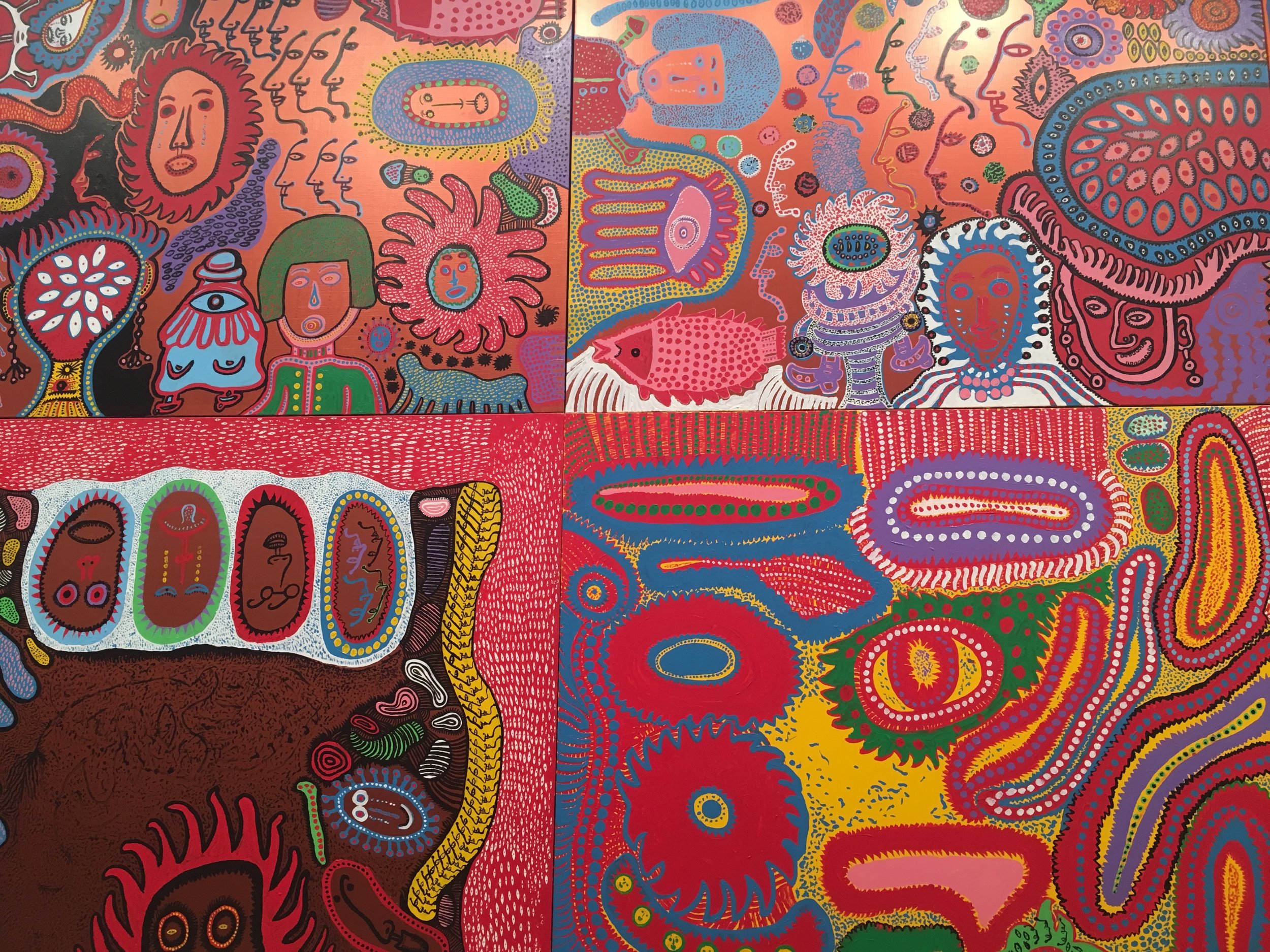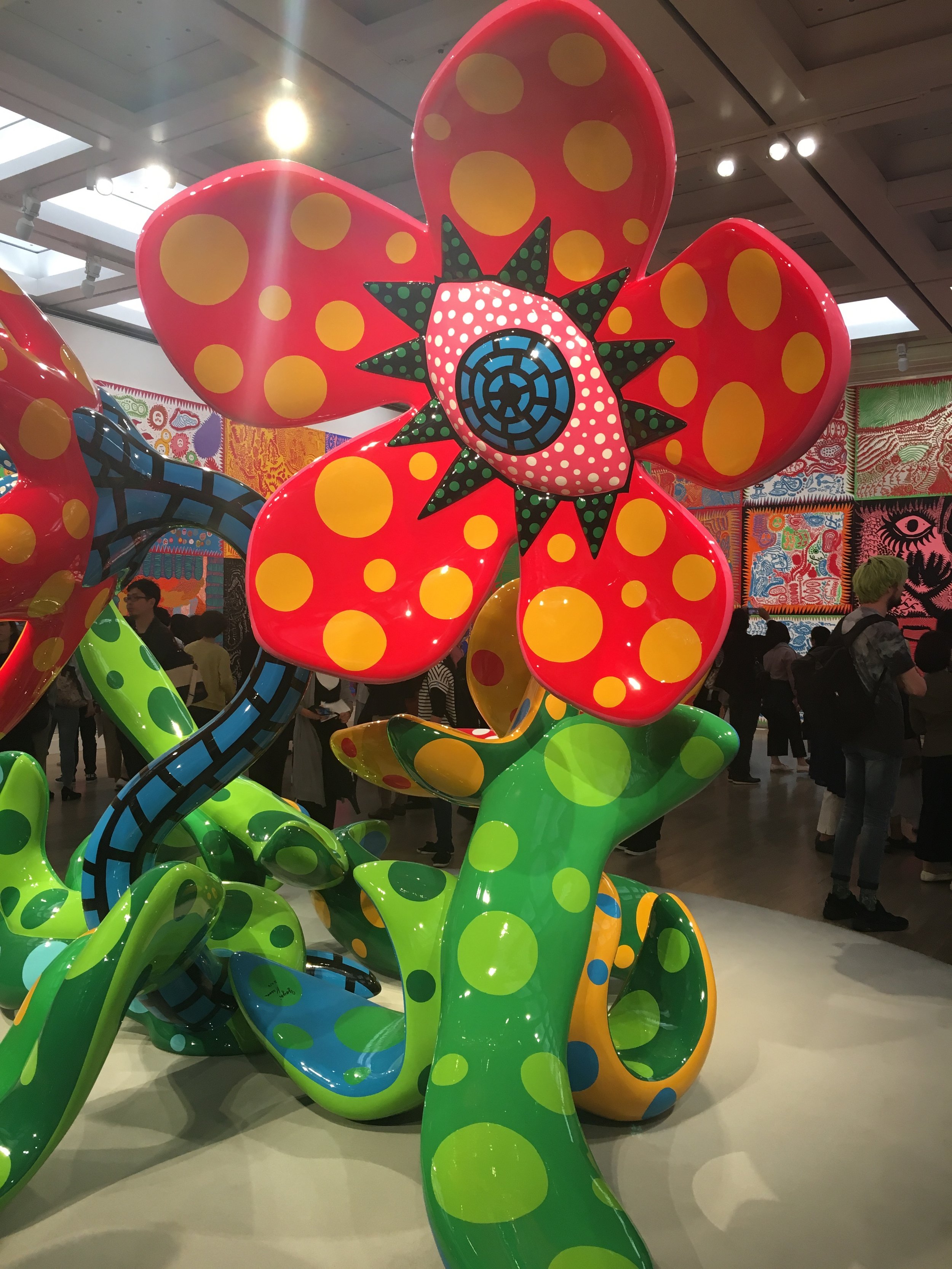When I grow up, I want to be Yayoi Kusama. At 87, the Japanese artist wears her hair a shocking orange-red and paints psychedelic scenes of abstract polkadot landscapes you suspect you may once have seen in a high fever. She is the ultimate crazy cat lady, if the felines formed a world-touring art exhibit that people were still queueing for forty minutes to enter on its penultimate weekend [*].
Kusama was born in Matsumato, Nagano; a prefecture to the west of Tokyo. Her family owned a seed farm, leading to an obsession with pumpkins that later became an orange-and-black polkadotted trade mark of Kusama's art. She turned to art as a child as a way of dealing with hallucinations that would plague her through life. She later stated that everyday was a struggle and her art allowed people a glimpse of the world as she experienced it.
A classic Yayoi Kusama pumpkin
'My Eternal Soul' is an exhibition of over 270 works that was being displayed at Tokyo's National Art Center. A giant orange-and-black pumpkin sat outside the museum main entrance and even the surrounding trees had got into the spirit of spots, with their lower halves wrapped in red and white polkadot paper.
Just inside the entrance was a room where visitors could create their own Yayoi Kusama piece. Originally filled with white decor, including a giant white teddy bear, museum goers had covered every surface with sticky dots offered at the doorway. A few people decided becoming one with the art was more to their taste and put the dots on themselves, while I spotted two others in lurid pink wigs in homage to the artist herself.
Visitors were given sticky dots to decorate an originally white room. I ultimately put an orange dot on the teddy's right foot. It was an excellent contribution.
When we arrived just before noon, the queue to enter the actual exhibit sat at 40 minutes long. This was the penultimate weekend for the show and clearly no one had had their fill of spotted craziness. They were not to be disappointed. The first room of the exhibit was a huge exhibition hall, with walls covered with tightly packed square canvases, each more lurid than the last. While the overall abstract theme and bright colours were consistent throughout, there was an evolution to the pieces, with varying styles from abstract shapes to misshapen faces clustered together. In the centre of the room were huge vividly coloured flowers entitled "flowers that bloom at midnight" and with them, the answer to all my questions about why traditional Japanese houses don't have big gardens.








In the surrounding rooms were pieces from Kusama's earlier career. Stretching over 70 years, her style initially seems extremely different. The shapes are less strong with softer brush strokes and colours muted to the point that some pieces are entirely white. This may be the influence from Kusama's first training in traditional Japanese art before she developed the boldness that is her current voice. However, the abstract theme is consistent and ever more frequently there is a lack of structure that sees the piece with no central focus.
Kusama's sculptures are pure white and of everyday objects such as boats, chairs, dressers and stepladders. Every single surface has a cluster of male penisus protruding from it.
Yes, you read that correctly.
When confronted with this proliferation of male genitalia, I wondered if my mind was just particularly filthy. Perhaps... coming from a farm... these were supposed to be... erm... sweet potatoes. It was in keeping with the whole pumpkin theme. Then I spotted the caption:
"Everyday objects with phallic protrusions."
Not sweet potatoes then. And no, I don't have pictures. I'm shocked you asked (... and photographs were only allowed in the main hall and interestingly, only on mobile phone cameras.).
I did wonder --as I tried to unsee the sprouting fungi of manhood on chairs and tables-- whether Kusama was representing human lives with these mundane objects and suggesting that all our interactions are dominated by sex. Then I wondered if I did not agree with that.
Apart from polkadots, Kusama is perhaps best known in circles that still contain children for her "infinity rooms". These mirrored chambers seem to extend lights and art work in all three dimensions. The one on display showed different coloured lights stretching away in all directions including below your feet. I'd recently used a virtual reality headset with a VR version of Google Earth that almost threw me to the floor by ejecting me off the planet to stand in space. This was a similar sensation and everyone was glad I'd not yet had lunch.
Turfed out into the gift shop, I noticed to mild horror that not only were there plushie forms of the artist to buy, but customers had been specifically asked to limit themselves to 10. Do I even want to know why there was such a high demand for bulk Kusama-felt-version purchases?
No.
__
[*] To be clear, I WOULD queue for forty minutes to see a crazy cat lady's cats. I just suspect I wouldn't have to.






